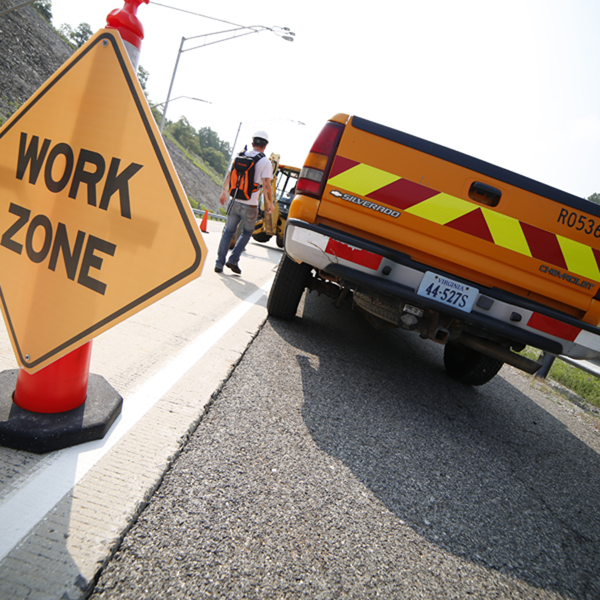
Abstract
Roadside work zones (WZs) present imminent safety hazards for roadway workers as well as passing motorists. In 2016, 764 fatalities occurred in work zones in the United States due to motor vehicle traffic crashes. A number of factors (aging highway infrastructure, increased road work, increased levels of traffic and more nighttime WZs) have led to an increase in WZ crashes in the past few years. Traffic collisions have become the second most common cause of worker fatalities. Consequently, WZs are becoming increasingly dangerous for workers as well as passing motorists. However, the advent of connected and automated vehicles (CAVs) are driving WZ safety practitioners and vehicle designers towards implementing solutions that will more accurately describe activity in WZs to help identify and communicate imminent safety hazards that elevate crash risks. A viable solution to this problem is to accurately localize, monitor, and predict WZ actors’ collision threat based on their movements and activities. This information along with CAV’s trajectories can be used to detect potential proximity conflicts and provide advanced warnings to workers, passing drivers, and automated vehicle control systems. This project aims at addressing this problem by delivering a specification for a wearable worker localization and communication system prototype that utilizes ultra wide-band (UWB) technologies to facilitate real-time threat detection and warning algorithms. As a result, this research is expected to significantly improve the safety conditions of roadside WZs through prompt detection and communication of hazardous situations to workers and CAVs alike.
Project Highlights
A demonstration was conducted for VDOT and VTRC stakeholders on the Virginia Smart Roads in May 2019 to show the effectiveness of the threat detection algorithms developed in Task 4 and the capabilities of the UWB system. This demo served as a platform to discuss potential follow-on development activities (Safe-D project: 04-104) relating to the localization of work zone entities and associated warning strategies.
A conference paper was developed and was submitted and accepted for oral presentation at “International Workshop on Computing in Civil Engineering” (1C3E). The conference paper was invited to be published in the ASCE Journal of Computing in Civil Engineering’s special issue.
One Master’s Thesis was completed resulting in one student’s graduation.
Han, W. (2019), “A Connected Work Zone Hazard Detection System For Highway Construction”, Master’s thesis, Department of Industrial Systems and Engineering, Virginia Polytechnic Institute and State University, Blacksburg, Virginia, USA
Final Report
EWD & T2 Products
Poster Presentation (pdf): This poster was presented by the Graduate Research Assistant, Wenjun Han, during the Automation Hub Ribbon Cutting event on 11-27-19. This was presented to various transportation research stakeholders.
Class Module (pptx): These slides were presented by Dr. Roofigari-Esfehan undergraduate course (BC 2114: IT in Construction) at VT during Fall 2018 semester and can be used in future course instruction, as appropriate.
Presentation Slides (pdf): This presentation was given by Wenjun Han, GRA, during the I3CE conference in Atlanta on June 18, 2019.
UWB Demonstration Video (mp4): This video showcases the UWB technology used during this project as well as the associated CAV applications used to send real-time alerts to pass CAVs.
Student Impact Statement (pdf): Two students were funded under this project (Wenjun Han, Master’s student from VT and Daniel Linares, Ph.D. student from VT). This file contains a statement of the impact this project made on these students’ education and workforce development.
Presentations/Publications
Han, W., White, E., Mollenhauer, M. and Roofigari-Esfahan, N. (2019) “A Connected Work Zone Hazard Detection System for Roadway Construction Workers”, Proceeding of International Conference on Computing in Civil Engineering, Smart Cities, Sustainability and Resilience, pp 242-250; doi:10.1061/9780784482445.031 (Published)
Han, W., White, E., Mollenhauer, M., Roofigari-Esfahan, N. (2019). Proceedings from ASCE International Conference on Computing in Civil Engineering 2019. Atlanta, GA. (Accepted)
Han, W., White, E., Mollenhauer, M., & Roofigari-Esfahan, N. (2019, June 13). A Connected Work Zone Hazard Detection System for Roadway Construction Workers. Computing in Civil Engineering 2019: Smart Cities, Sustainability, and Resilience. doi:https://doi.org/10.1061/9780784482445.031 (Published)
Research Investigators (PI*)
Mike Mollenhauer (VTTI/VT)*
Elizabeth White (VTTI/VT)
Nazila Roofigari-Esfahan (VT)
Project Information
Start Date: 03/01/2018
End Date: 02/28/2019
Status: Complete
Grant Number: 69A3551747115
Total Funding: $510,710
Source Organization: Safe-D National UTC
Project Number: 03-050
Safe-D Theme Areas
Connected Vehicles
Automated Vehicles
Safe-D Application Areas
Operations and Design
Risk Assessment
Driver Factors and Interfaces
Infrastructure Technology
More Information
RiP URL
UTC Project Information Form
Sponsor Organization
Office of the Assistant Secretary for Research and Technology
University Transportation Centers Program
Department of Transportation
Washington, DC 20590 United States
Performing Organization
Virginia Polytechnic Institute and State University
Virginia Tech Transportation Institute
3500 Transportation Research Plaza
Blacksburg, Virginia 24061
USA
